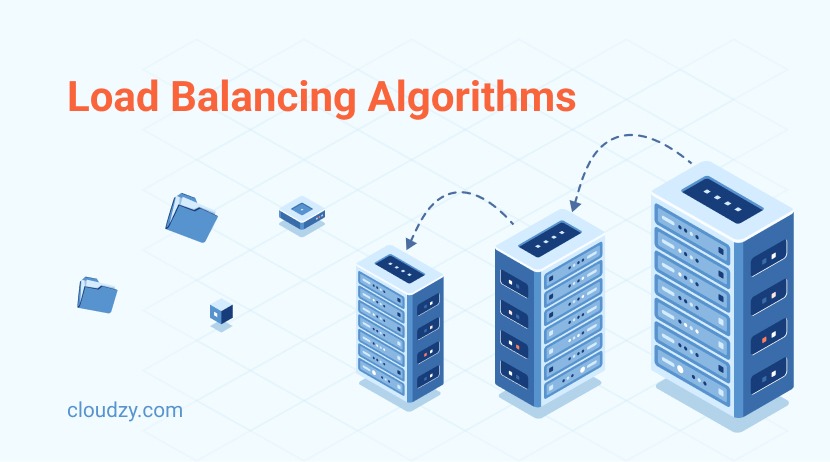There are lots of different load balancing algorithms in cloud computing and each of these algorithms has its specific use case. To learn about the reason behind this diversity, we should go back in time to the late 1980s and early 1990s when we first introduced distributed computing systems. Those days, our only challenge was to manage the distribution of computational tasks across a network of computers to enhance efficiency and minimize response time. Those basic load balancing algorithms only focused on static methods that did not account for real-time changes in network traffic or server load.
As the internet expanded in the mid-1990s, we could feel the demand for more dynamic and intelligent load balancing algorithms. The rapid growth in using the internet meant that websites and online services had to respond to more users and manage large volumes of traffic. So, we had to develop algorithms that could adapt in real-time, such as the Least Connections and Round Robin methods.
Then, we moved to the 21st century and the emergence of cloud computing meant we needed even more sophisticated load balancing techniques. Algorithms had to not only distribute loads within a single data center but also across global networks. This third phase brought about advanced load balancing methods that are able to incorporate machine learning and predictive analytics. This way, they can anticipate traffic spikes and adjust resources seamlessly.
As you can see in this short history of load balancing algorithms, there are lots of methods that each have a specific use case. The reason behind this diversity is that different computing environments and applications have special demands that should be addressed with the right algorithm. If you want to know about all these different cloud load balancing algorithms, follow this guide to learn all the essentials.
What Are Load Balancing Algorithms?
Before any detailed explanation, you need to know that load balancing algorithms fall into two general categories: static load balancing and dynamic load balancing. Dynamic load balancing refers to algorithms that first consider the current load of each server and then distribute the traffic. This category is great for an adaptable and efficient traffic management system. Static load balancing refers to more traditional approaches that don’t make any specific adjustments based on the current server load. The algorithms in this category are simpler and less resource-intensive but aren’t always the most optimal solution. The different types of load balancing algorithms that we cover here are either dynamic or static.
Dynamic Load Balancing Algorithms
-
Least Connection
This algorithm directs new incoming requests to the server that has the fewest active connections. To do so, it has to assess the current load on each server while considering all the active and pending connections. This approach is highly effective in environments where session durations are unpredictable.
-
Weighted Least Connection
This algorithm is very similar to the Least Connection algorithm. It’s able to incorporate server capacity into the decision-making process. It gives each server a weight based on its capacity (CPU, memory, etc.), then the algorithm chooses a server that has fewer connections relative to its weight. This load balancing algorithm allows for a more detailed distribution of traffic.
-
Weighted Response Time
This dynamic load balancing algorithm can route traffic based on server response times. This way, it can assess which servers have faster responses and then give a heavier load to those servers. By preferring servers with quicker responses, this algorithm enhances the overall application performance and user experience.
-
Resource-Based
This dynamic load balancing algorithm focuses on the resource availability of servers (including CPU load, memory usage, and network bandwidth). This algorithm assigns requests to a server that’s most capable. Applying this technique requires real-time monitoring of server resources to dynamically distribute traffic.
Static Load Balancing Algorithms
-
Round Robin
This static load balancing algorithm cycles through the servers in a predetermined order. In other words, it distributes incoming requests sequentially among all servers in a pool. This method is pretty straightforward: each server is given a turn in a rotating sequence and receives a request based on its turn. As you can guess, this approach does not account for varying server capacities or current loads.
-
Weighted Round Robin
This algorithm is an enhancement of the Round Robin approach. Just like other weighted methods, it assigns a weight to each server based on its capacity. Servers with higher weights receive a larger share of requests. This method allows for a degree of load distribution according to server capability. However, it still does not adjust to real-time server load.
-
IP Hash
This static load balancing algorithm uses a hash of the incoming request’s IP address to assign requests to servers. With this approach, every request from the same IP address goes to the same server. But what’s the point of pairing IPs and servers? This approach can enhance session persistence by consistently directing requests from the same client IP address to the same server. While it offers an easy way to maintain session integrity, it might not evenly distribute traffic if the client IP distribution is skewed.
Dynamic and static load balancing algorithms each have their strengths and use cases. Dynamic algorithms adapt to real-time conditions; so it offers a more fluid and responsive approach to traffic management. Static algorithms, on the other hand, provide a predictable distribution method that’s very simple and reliable.

Load Balancing Algorithms in Cloud Computing
An efficient algorithm for load balancing can greatly enhance the performance and reliability of a cloud environment. There’s a long list of all the advantages that cloud load balancing has for your enterprise. Optimized resource allocation, improved user experience, and increased reliability are a few of these benefits.
For the purpose of this blog, let’s focus on the impact of two load balancing algorithms on cloud environments. Imagine you’re in a large and crowded coffee shop where a lot of people are waiting for their order. The quality of customer service and the satisfaction of customers rely on how the manager of the coffee shop handles this workload. Now, if you were the manager, how would you handle the queues at this coffee shop? Let’s say you know about least connection and weighted least connection algorithms, and you decide to implement the logic behind these two algorithms to solve this issue. To do so, you should allow baristas with shorter lines or those capable of working faster to take on new orders. This way, you can make sure customers are served as fast as possible and you’re using your resources efficiently.
In cloud environments, this approach not only optimizes server utilization but also significantly reduces response times for users. By dynamically allocating requests based on current server load and capacity, these algorithms help maintain high levels of efficiency and user satisfaction, making cloud services more reliable and scalable.
Want a high-performance Cloud VPS? Get yours today and only pay for what you use with Cloudzy!![]() Cloud VPS
Cloud VPS
Conclusion
In this blog post, we reviewed all the important types of load balancing algorithms and talked about how these algorithms can alter your cloud experience for the better. A suitable load balancing algorithm makes sure that the workload is distributed efficiently and brings out the best performance of your cloud infrastructure. Cloudzy’s Cloud VPS solutions exemplify this by offering optimized environments for the seamless application of such algorithms. So, you can be sure that your cloud ventures are both high-performing and resilient. With Cloudzy, you gain access to cutting-edge technology and 24/7 support, making sure your cloud-based applications run smoothly and efficiently. Choose Cloudzy to power your cloud journey, where performance meets reliability.
FAQ
Which algorithm is best for load balancing?
The “best” algorithm varies by application needs; however, Weighted Round Robin is popular for its simplicity and efficiency because it allows for weighted distribution based on server capacity.
How many load balancing algorithms are there?
There are dozens of load balancing algorithms that are generally categorized into static and dynamic methods. Popular ones include Round Robin, Least Connections, and IP Hash.
What is dynamic load balancing algorithm?
Dynamic load balancing algorithms adjust the distribution of work in real-time based on current server load. This way, they can guarantee optimal resource utilization and performance without manual intervention.




